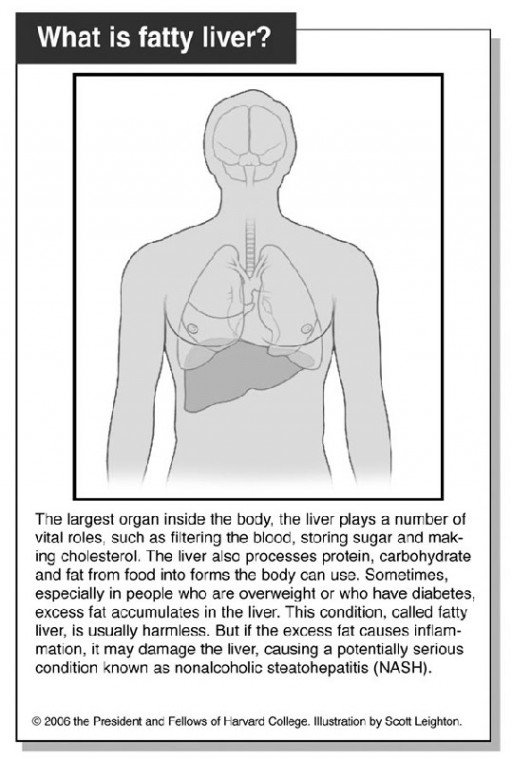Q: What is fatty liver disease?
A: Fatty liver is a condition caused by the buildup of fat in
liver cells.
By the Faculty of Harvard Medical School.
Q: What is fatty liver disease?
A: Fatty liver is a condition caused by the buildup of fat in liver cells. Also known as nonalcoholic fatty liver (NAFL), it affects between 10 percent to 20 percent of Americans. Fatty liver is most common in people who are very overweight or who have diabetes. And although having a fatty liver isn’t normal, it rarely causes damage to the liver and doesn’t require treatment. It’s thought to develop when blood that travels to the liver from the small intestine delivers more fat than the liver can handle. Fat cells can also pile up because of defects in the way the liver breaks down fat.
However, fat in the liver can also be a sign of a less common but more serious condition called nonalcoholic steatohepatitis (NASH). In NASH, the excess fat cells cause inflammation, which can damage the liver. Like NAFLD, it is most common among people with diabetes or those who weigh 10 percent to 40 percent more than their ideal body weight. But it can occur in both adults and children without those conditions. For reasons that aren’t clear, it afflicts more women than men. The damage to the liver resembles that seen with alcoholic liver disease, but NASH occurs in people who drink little or no alcohol. An estimated 2 percent to 5 percent of Americans have NASH.
One sign of fatty liver disease is higher-than-normal levels of liver enzymes, which can be detected by a routine blood test. If a person has no other apparent reason that might explain these abnormal levels (such as medications, viral hepatitis or excess alcohol use) a doctor may suspect fatty liver and recommend an X-ray, ultrasound or other imaging test. These tests can show whether the liver has excess fat. But the only way to know for certain whether a person has NASH is through a liver biopsy.
Although it involves inserting a long needle into a person’s right side to remove a small piece of the liver, a liver biopsy isn’t complicated, only slightly painful (a painkiller is used) and doesn’t require a hospital stay. If the liver sample shows signs of fat along with inflammation and damage to liver cells, then the person is diagnosed with NASH.
Most people with NASH don’t have any symptoms. When they do, the symptoms are often vague. They may feel unwell, tired, or perhaps have an achy feeling on the right side of the abdomen where the liver is located. But for up to 20 percent of patients, NASH is the beginning of a dangerous cycle that leads to fibrosis, a buildup of scar tissue in the liver. Fibrosis can lead to life-threatening cirrhosis, which involves severe damage to the liver.
At present, doctors can’t accurately predict if or when NASH will cause problems. But people who are older, obese and have diabetes appear to be more prone to developing serious complications from NASH. If the liver shows no abnormalities other than NASH, the doctor will probably take a wait-and-see approach, advising the person to lose some weight. They might also monitor the blood-sugar levels of their diabetic patients more closely. Some clinicians advise strict cholesterol control. And because alcohol can cause the same kind of liver problems, doctors will also advise patients to cut back on alcohol consumption.
Researchers are studying several experimental treatments for NASH, including antioxidants (such as vitamin E) and drugs used to treat diabetes (such as metformin). But it’s too early to know whether they will help.
Usually, NASH isn’t as serious as hepatitis caused by alcohol. Still, protecting your liver seems to be yet another reason to keep the pounds off. If you are overweight or diabetic – or, particularly, both – you should discuss NASH with your doctor to see whether tests, or possibly treatment, are warranted.
Submit questions to the Harvard Medical School Adviser at www.health.harvard.edu/adviser. Unfortunately, personal responses are not possible.













